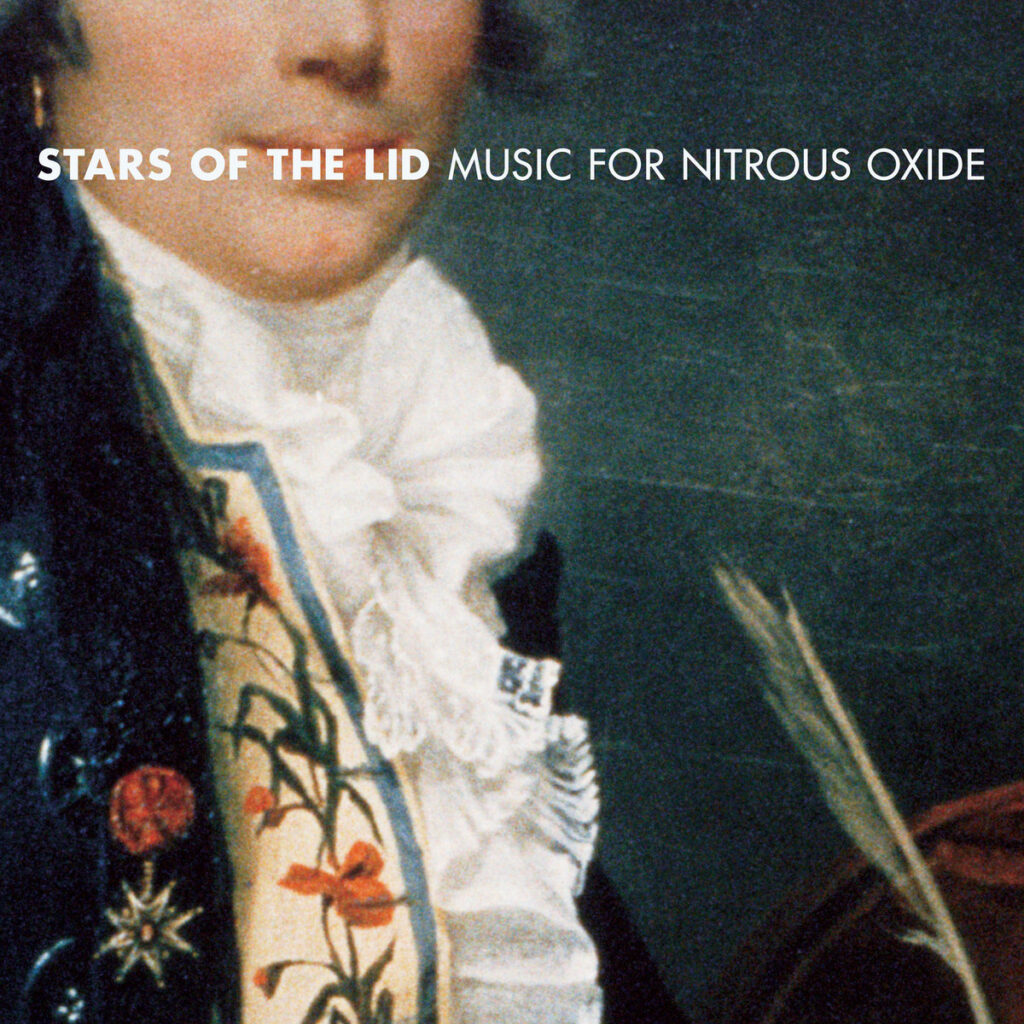A twenty-minute video filmed at Other Music, a record store in New York, captures Stars Of The Lid live in 1996. Shot on a camcorder, the duo, the late Brian McBride and Adam Wiltzie, are playing in a seemingly ad hoc space. While the latter stands next to a bookcase and a ladder, the former is perched left of frame by a door opening onto a packed closet. They tune up and chat, a guitar chord hits a longtailed delay and starts looping. The point where the banter stops and performance starts isn’t clear cut.
In terms of video, it captures a sparsely documented stage of Stars Of The Lid’s history, nearly two decades before they would return to NYC to play in a church for Boiler Room, but this time bolstered by a chamber orchestra. This nineties incarnation of SOTL is more serrated, weirder, and ragged. But the elegant grasp of tone, pace and atmosphere are already there. Midway through their performance, McBride’s guitar starts to pierce the shroud with single notes equally evoking a trumpet and a violin, a premonition of SOTL’s later, more orchestral albums. It creates a throughline to the landmark The Tired Sounds Of and …And Their Refinement Of The Decline.
The Other Music show took place a year after the release of their debut, Music For Nitrous Oxide. That album came out on Sedimental Records on CD, and has now been remastered and reissued on vinyl by Wiltzie’s Artificial Pinearch Manufacturing imprint. Like the live video, it documents where SOTL came from and hints at where they were going, distilling aspects of their early music that continue resonating today.
For me, Stars Of The Lid have always been tied to mental fatigue and brain rot, the viscous feeling after a day spent doing something simultaneously tedious and mentally exhausting – a sensation I equate with a variety of jobs in retail, stockrooms and offices. Their music feels most vital when the listener is in this state, when they have left the churn and need to take some space to hook body and self-back together. That might seem new age-y, but SOTL always sound too damaged for that categorisation to make absolute sense. The beauty comes from the reflections of inner turmoil.
At their most elegiac, their records act as a salve, a sanctuary to suture the mind whole. But there’s also a discombobulating surreality. Music For Nitrous Oxide isn’t their most influential album. Nor does it have the majestic sense of balancing on a time dilated precipice that ripples through The Ballasted Orchestra. But it is the record where they can be heard most directly evoking the process of the brain unspooling, and all the darkness and light that might be freed.
David Lynch references occur throughout SOTL’s catalogue, but Nitrous Oxide is the album that sounds most Lynchian. Much of it breathes the same air as the twin guitar levitations captured in the Other Music video. But things also trip further sideways, a weirdness amplified by the fact these moments arise so subtly. ‘Down’ begins with a sample from Star Trek: The Next Generation’s Force Of Nature episode, a strange prelude to a tableau of back-spinning piano and guitar. On ‘Lagging’, ghostly shimmers underpin a collage of extra-terrestrial speculation and what sounds like the noise of a battlefield. The remarkable ‘Tape Hiss Makes Me Happy’ is a seared distortion bath which exhales webs of cursed atmospherics, a concoction that still sounds profoundly disturbed thirty years later.
The ominously surreal edge goes beyond the use of samples. On ‘Adamord’, a lulling motif gasps through frizzled static. ‘The Swellsong’ has immense gulps of bass, a disembodied voice and a fidgeting tapestry of scrapes, rustles and clinks – a confused perspective where relations of distance and proximity are askew. The album’s title suggests hymning laughing gas. Its cover is a painting of Armand Louis Le Boulanger, Marquis d’Acqueville, photographed by SOTL’s friend Patrick Lakey. A flamboyant portrait of an eighteenth-century French aristocrat, even in a gallery setting this painting would be subtly odd, but as a cover for this record it’s truly bizarre.
It points to an under explored lineage the band sit in. SOTL emerged in the post-grunge landscape of the US underground. They helped create the aesthetics of the Kranky label. They were associated with post rock, while their work sits more naturally in the longue durée of ambient, drone and experimental composition. In interviews, the duo explained how in their early years they felt isolated in their Austin hometown, playing delicate drones in what Wiltzie describes as “a rock & roll village”. If there was one Austin band they shared unlikely ground with however it was the Butthole Surfers. The comparison does not require as great a leap of the imagination as it might seem on first contact however, as it makes more sense than cataloguing them with Tortoise or Stereolab. Where SOTL jettisoned any hint of rock sonics and theatrics Butthole Surfers pushed them to pyrotechnic enhanced extremes. But there’s a sense that both bands were trying to unravel rock music, one through a recklessly additive process, the other through subtraction. At the surface level there is little to connect these groups sonically, but on Nitrous Oxide we hear SOTL plumbing similar unsettled undercurrents to the Butthole Surfers. A radically different form of psychedelic music which seems to sprout from the detritus of information saturated modern living. It’s a connection that’s more than tentatively aesthetic – in 1997 SOTL released a split with Labradford, The Kahanek Incident Vol. 3, on Trance Syndicate – a label run by Butthole Surfers drummer King Coffey. On Nitrous Oxide, SOTL come across as the nocturnal, somnambulant underside to the surreal, media warped terrain explored by a stream of outlying artists in the US from the late 70s onwards – from The Residents through to Negativland and onto the Butthole Surfers – a lineage which coexisted with but sat askance to the cycles of punk, hardcore, indie rock and grunge.
In context, it’s not that surprising. While SOTL’s later years saw McBride and Wiltzie developing their music while living on different continents, sending ideas back and forth to develop in slow motion, early on they worked face to face, recording on cassette four-track. As Wiltzie explained in Kranky co-founder Bruce Adams’ memoir You’re With Stupid: “Everything was captured on those little archaic devices. Brian had a radio show, he mixed four-track tape bits and bobs in and out of records with found samples, and anything else he could find. We were constantly making cassette mixes of his radio show stuff with all of the guitar drones I was making in my house.”
Elsewhere in Adams’ book, McBride describes the duo watching the finale of Twin Peaks season 2 on mushrooms before “getting their drone on”. It provides a window into how they worked in their early years. Nitrous Oxide came about when Sedimental’s Rob Forman heard one of these cassettes and asked them to condense the music into a CD. The near seventy-minute duration of the album comes from them hitting the upper limit of what that format could contain. The decision to put this reissue on vinyl is of course appealing to wax fetishists, but for better or worse it also adds interruptions to music that originally landed as one continuous stream.
When I was watching a video of The Kahanek Incident Vol. 3 on Youtube while researching this review, the ultra-minimal textures of the tracks, formed from Labradford and SOTL remixing each other, kept being interrupted. A particularly lush moment was violently ended by a jingle and ad for cat food. It was oddly portentous, an overlap that felt connected to the surreal juxtapositions on Nitrous Oxide. Ruptures that algorithms make disturbing in the present, SOTL enchanted in 1995.
In 2025 there’s no end of reasons to worry about our brains being stretched thin. AI is seemingly designed to absorb the most stimulating aspects of work and only leave the most tedious, the fragmented stream of information broadcast from the internet, the mind-numbing nature of many jobs. There are plenty of reasons to want to reach for and find solace in SOTL’s music. All their records offer escape vectors, but their debut is especially effective at presenting a roadmap to guide the listener through webs of drift and disjuncture.
Music For Nitrous Oxide is out today via Artificial Pinearch Manufacturing



